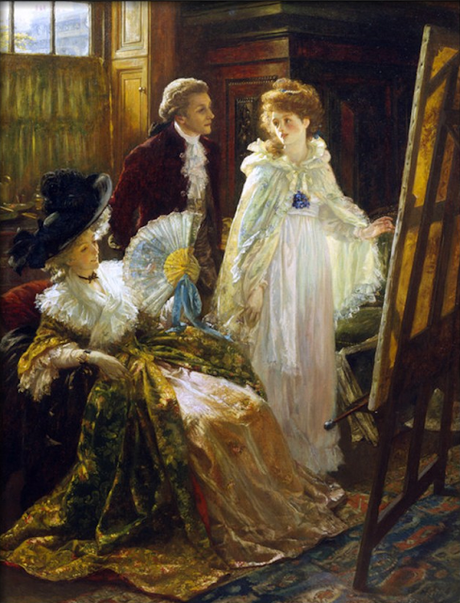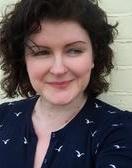Well, here we are at the end of Blogvent and we have met some incredible women this month and I am left with some truths universally acknowledged:
1. Don't work from London - if you are working from a town outside London, you will be a hero in the local press. You will be praised to the roof tops every time you exhibit anything and if you reach the Royal Academy, you will be loved even more. They are also more likely to do a nice obituary for you, which will help your future biographers.
2. Try not to be related to another artist, especially if he is famous before you even start painting - the problem with a famous father is that you will always be in his shadow and compared to him. Art historians will go on about how your work is far inferior to his and you are a pale copy. If he is your husband or brother and you are working at the same time, there is a very good chance that people will mistake your work for his. How many Emma Sandys are labelled as Fred Sandys? When Charles Gogin died, the newspapers said how Reigate had been given three paintings by him by his wife. Problem was that only two of the pictures were his and the other was hers.
Mind you, if your husband/brother/father is extra famous, you stand a very good chance of appearing in his biography. Marion Collier's early life benefited from being a Huxley. Even if you only glance into a great man's orbit, there is a good chance you will leave a trail that future art historians and biographers can follow. Try and leave some letters, that's always a great place to start.
3. Make friends with a journalist from the Queen - I can't even begin to explain how much that publication has saved me this month. It really cared about women artists and wanted to share their stories, their pictures and their photographs. God bless the Queen!
4. Try and be wealthy - it will make your career easier. Actually, that one is probably good advice full stop. Damn, I wish I could take my own advice...
This month I have been using the Royal Academy catalogues (both the text and the illustrated one) to find when our ladies were exhibiting and if I could find one of their paintings in the accompanying book (I was ever the optimist). I began to wonder if there was any correlation between time passing and the position of women in the RA. Obviously, this is not wholly scientific in a general sense, but we only have today left and I thought if I took two random years and looked at how women fared, we could see if the Victorians really were the repressive regime we assume and whether things really did change in a couple of decades with those ever-so modern Edwardians.
I took the 1892 RA and the 1914 RA as my test subjects because they were the earliest RA I could find with an illustration booklet and I thought I would use 1914 because enough men might die in the following few years to skew my results. By 1892, women had access to art schools and so you could argue that more women in the art establishment in the role of creator rather than the model would make a difference, not only in the people creating, but also what was created.
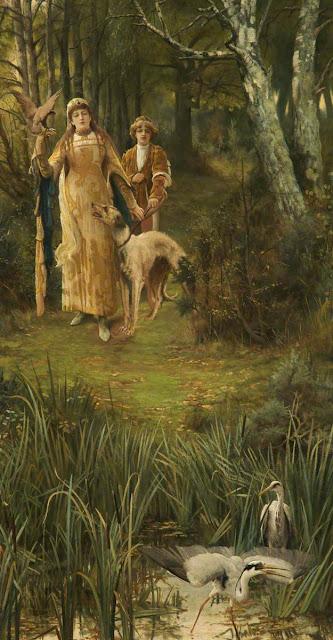
Hawking (undated) Laura Alma-Tadema
Starting with the stats for 1892: at the RA that year there were 2007 works of art created by 1262 artists. Among those were 242 women. That is not great, less than 20% but that would mean (if we were being optimistic) that one in six illustrations should be from women in the catalog. The illustrated catalog had 200 illustrations, so around 38 of them should be by female artists. Even if we went with number of artists rather than number of illustrations, then out of the 156 artists illustrated, we should get 29. Actually, we had 9, which is less than 6%. They were by Laura Alma-Tadema, Hilda Montalba, Elizabeth Forbes, Jessie Macgregor, Henrietta Rae, Margaret Dicksee, Maud Goodman, Louise Jopling and Margaret Bird. Of those women, at least two, Rae and Jopling, had absolutely built themselves big careers at this point, Elizabeth Forbes and Laura Alma Tadema were married to artists who were well-known, Margaret Dicksee was from an art family with a famous father and brother. My point about not being related to anyone (above) is obviously wrong as it didn't harm those women in this instance.
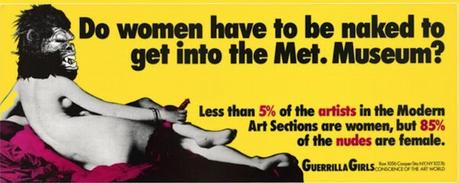
1989 Guerrilla Girls' poster
So, if the female 6% made it to the catalog through being artists, what about in subject matter? When you start breaking down the paintings, you notice that rather a lot of women appear in the catalogue, they just have got their boobs out. Some of them are rich enough (or married to someone rich enough) to have their portrait painted (boobs hidden). Eleven of them are in distress. Thirteen of them are 'classical' which means they aren't naked but we can all see nipples through that frock, you're fooling no-one. Sixteen of them are pretty ladies with their clothes on and six of them are untrustworthy, tricksy minxes. There is one instance of male nudity, and male portraits are more prevalent that female. There are twenty paintings of men being heroic, six of men with beards being serious, two of men in kilts and another two of soldiers being awfully brave (in addition to men being individually heroic). When you break it down, despite what was said to Alma Gogin about portraits not entering the RA easily, portraits got a lot of attention in the illustrations, followed by landscapes and waterscapes (non-fishing). My favorite category, 'Poor People Being Sad,' scored five, and to be fair, they are mostly women too.
Off to 1914, and George V is on the throne, we are about to get into a massive war and women are off to factories and on their way to the vote (I have a thing about saying we were 'given' the vote, the Powers That Be just stopped withholding it in 1928) and if I am so inclined, the end of the 'Long Victorian' period is in sight. Surely things have changed radically, right?
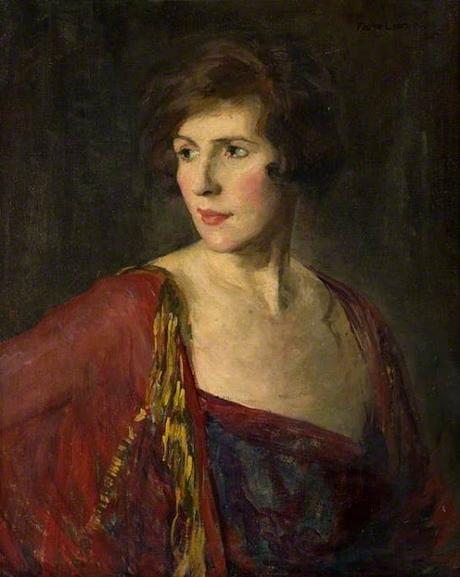
Mrs Ralph Peto (1921) Flora Lion
There were 2245 paintings in the 1914 RA, by 1526 artists. Of those, 517 were women. That is 34%! That is a massive jump, so I can look forward to a third of the illustrations being from women - hurrah! There are 238 illustrations in the book and a third would be around 78. We got 15, which is 6 and a bit. So, about the same then. Rats. Those women were Mary Young Hunter, Lucy Kemp-Welch, Flora M Reid, Laura Knight, Jessie Macgregor, Mia Arnesby Brown, Hilda Fearon, Marianne Stokes, Henrietta Rae, Nellie M Hepburn-Edmunds, Daisy Radcliffe Beresford, Flora Lion, Mary Waller, Alice Fanner and Mary F. Raphael. A couple of names remain the same, a few female painters have become famous in the meantime (Laura Knight, Lucy Kemp-Welch), but a fair number I had no idea about.
Angelica Kauffmann, introduced by Lady Wentworth, visits Mr. Reynolds’ studio (1892)
Margaret Dicksee
How about subject matter? Surely that would have changed? Oh, absolutely and full-frontal nudity increased, whereas just topless stuff dropped back, so apparently boobs were not enough anymore. I have to admit there were not as many obviously distressed women in 1914 (well, in illustration) but the quota of men being all heroic was still quite high. I am being flippant, but the lack of women being disappointed in men to varying degrees is interesting because, in all other ways, the subject matter of the paintings was remarkably similar. Were men incapable of disappointing women in 1914? Could we not afford to show our womenfolk in domestic distress when a war loomed on the horizon and we might need them to look distressed about other men, foreign men?
In 1895, it was reported in the newspapers that an art critic had chosen the 30 best pictures out of the whole Royal Academy exhibition (which we know ran into a thousand or two) and he chose only three by women - one each by Lady Butler, Jessie Macgregor and Elizabeth Forbes. As the Yarmouth Gazette mused
'Three out of thirty seems a small percentage, but it must be remembered that it has been only during the last few years that facilities have been offered to girl students such as they have recently enjoyed. The profession of artist, even for men, is not yet quite free from the suspicion of Bohemianism and until some five or six years ago the ladies who adopted it as their chosen path in life were regarded by their friends as almost social pariahs, and had a fair amount of roughness to encounter.'
Well now, that's the reason that women artists are not appreciated! They have only just had the training and those that attempted it before were made social outcasts because of all the Bohemianism. It all becomes clear, it's not because of societal prejudice then. That's all fine then.
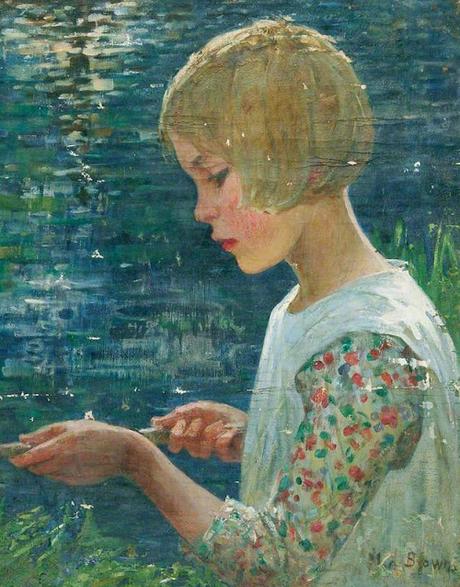
Girl Fishing (c.1918) Mia Arnesby Brown
In case you weren't convinced of that argument, the Cheltenham Examiner is here to help - 'Except in pastels, watercolours and miniatures, women are seldom happy in strong portraiture. Though some of them may not think it, women have their limits, and that a sex limit.' Apparently our little lady hands can only make faint marks or else we swoon. Apologies.
It is easy to say 'sexism did it' when trying to explain why women did not get the chances. I also was once asked at an event if women artists weren't famous because they just weren't as good, but I don't feel I am being defensive by saying all of the women who made the RA were as good as the men who were there, and some of them were as exceptional as the best of the men. What worries me is the exceptional women who didn't get the chance to even blip on our radar. I read a horrifying fact when reading about Adah Knight which was that 13,000 pictures were submitted to the 1896 RA and they only had room for 1600. That's around 12% so what about the other 11,400 works of art and artists who did not make it? It's a miracle that women made it there at all, and for that matter, what about working class men and people of color - how can I tell just by looking at a name what the story for that person is? The RA catalogues are filled with names that have slipped into obscurity. Who knows what secrets they hold?
I need to go to bed as Father Christmas is on his way, but I think our plan of action is this - the internet is stuffed with free resources - on Archive.org, on the Royal Academy page, on ArtUK - find an artist who is obscure, whose art you love, and befriend her. Make her part of your family. Research the hell out of her and do not be put off by nonsense written in the newspapers about her or in the biography of very important men. Each little step along the way of putting these women back in the narrative is worthwhile. I couldn't find everything I wanted to about the women who graced Blogvent because I was doing it in 12 hour shifts. Imagine what can be found with more time and more digging.
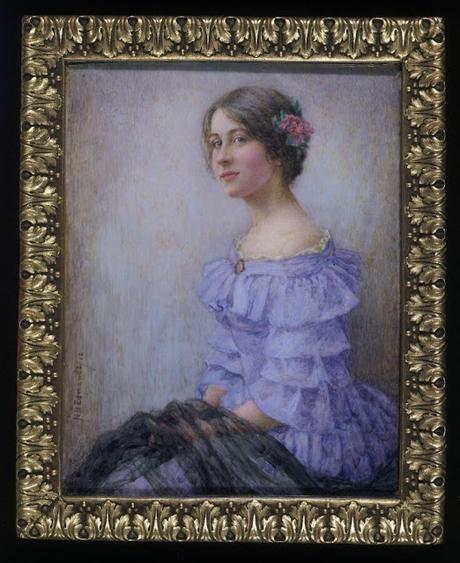
"She had two eyes so soft and brown, Take Care!
She gives a side glance and looks down, Beware!"
(1912-14) Nellie Hepburn Edmunds
It's all very well for me to look at the statistics behind the Royal Academy exhibitions and make tutting noises but if we leave these women in obscurity then we are not helping to highlight their work or proving the likes of the Cheltenham Examiner c.1902 wrong. If you liked one of the women from the last 23 days, start digging! Do a curation on ArtUK, write an article, see where has her work and go and visit it. If I have learned anything from the last thirty years of doing this sort of nonsense then it is this (and Fanny Cornforth will back me up here) : If you talk long enough and loudly enough about someone, people will join in and that person will become part of the conversation.
If I can do it, so can you. Happy Christmas.
